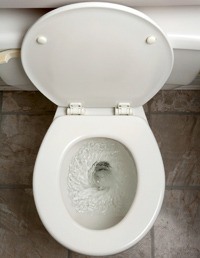What are you going to do when the water is shut off and you have one flush left in the toilet?
This can happen, by the way, for any number of reasons:
• A break in the water main disrupts delivery to your house
• An earthquake shatters water pipes
• Winter weather freezes the pipes
• Equipment failure of the community water supply
• Contamination of water supply disrupts water delivery
• Drought results in water shot1age
• Power outage shuts down community water pumps
Sanitation is a priority in a survival incident. If you don’t take care of sanitation, disease will soon find you. You must figure out how to handle the human waste problem. This is a situation that is easy to solve, yet most people never give it a second thought.
No matter where you live, you have options:
• Buy a chemical porta-potty (and extra chemicals)
• Use a five-gallon bucket, some plastic bags to line the bucket and a toilet seat that you place on top
• Dig a latrine, if you have property
• Get a composting toilet and some peat moss
A chemical porta-potty works well, but the holding tank is limited to a few gallons. Depending on family size, you might have to empty it every couple days. When you do, you’re dealing with wet sewage, so you’ll need to find a suitable disposal method.
A bucket is a poor man’s porta-potty. Lined with plastic bags, you can collect all the waste in the bag and haul it out for disposal. A toilet seat placed on the bucket makes things more comfortable.
A latrine is an excavated hole in the ground into which one makes a “direct deposit” when nature calls. If you cut the bottom out of the plastic bucket and position it over the latrine, you can have a place to sit while pondering your circumstances. Toss some soil or wood ashes over the deposit when finished. When one latrine spot has reached capacity, move to a new spot.
We have a composting toilet made by Nature’s Head (www.natureshead.net) that separates liquid from solid waste. The liquid goes into a collecting tank that holds a couple gallons and can be emptied when necessary. The solids go into a dry holding bin that contains peat moss.
By turning a hand crank after the deposit has been made, the human waste is mixed with the peat moss and, over time, it turns into compost.
Continuous air flow is necessary to support the composting process and a small fan is integrated into the system, powered by a 12-volt battery or small solar panel to sustain the air flow (vent to outside).
As composting occurs, the solid waste nearly disappears. The longer you wait before emptying, the better the compost gets, and the odor is virtually undetectable.
While we’re on this fine subject, have you given any thought to what you’ll do when you reach the last sheet of toilet paper on the last roll? You have options — stock up on toilet paper, use old newspapers and magazines, or “bottom friendly” plant leaves.
Take it from me, it’s a much happier situation if you buy toilet paper in bulk and have a healthy supply handy for emergencies.
Sequim resident Rich Johnson is a former Special Forces survival expert and author of several books, including “The Ultimate Survival Manual,” and “Rich Johnson’s Guide To Wilderness Survival.” These and other books of his are available at Amazon. Reach him via email at rhj@olypen.com.


